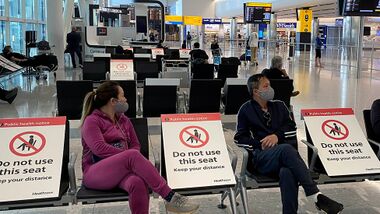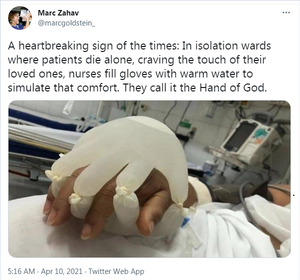Difference between revisions of "Social distancing"
(origins in a school paper) |
(add image+) |
||
| Line 12: | Line 12: | ||
'''Social distancing''' is a concept that is used to great effect as part of the [[COVID-19 deep event]]. | '''Social distancing''' is a concept that is used to great effect as part of the [[COVID-19 deep event]]. | ||
| − | The stated purpose was to stop infections by keeping people apart | + | ==Official narrative== |
| + | [[image:Glove dead.png|thumb]] | ||
| + | The stated purpose was to stop infections by keeping people physically apart. The idea involved keeping a set physical distance, often 1-2 meters from each other, in everyday actions, and avoiding hugs and gestures that involve direct physical contact ,like handshakes. Gathering in groups of 2 or more people were banned. | ||
| + | |||
| + | Elderly people were kept in virtual seclusion for months and years on end. Their relatives were kept away with the idea that physical contact would equal to "granny killing". <ref>https://www.huffingtonpost.co.uk/entry/dont-kill-granny-preston-coronavirus-slogan-young-people_uk_5f32a541c5b6960c066ca863</ref> | ||
| + | |||
| + | ==Purpose== | ||
| + | The real purpose is destroying any possibility of protest, sow distrust, disorient people, and weaken the physical and mental health of the population. It also is part of the deliberate destruction of the real-life economy. | ||
The first time it appeared in the [[New York Times]] was February 12, 2006: "If the avian flu goes pandemic while [[Tamiflu]] and [[vaccines]] are still in short supply, experts say, the only protection most Americans will have is “social distancing,” which is the new [[politically correct]] way of saying “[[quarantine]].”<ref>https://www.nytimes.com/2006/02/12/weekinreview/greetings-kill-primer-for-a-pandemic.html</ref> | The first time it appeared in the [[New York Times]] was February 12, 2006: "If the avian flu goes pandemic while [[Tamiflu]] and [[vaccines]] are still in short supply, experts say, the only protection most Americans will have is “social distancing,” which is the new [[politically correct]] way of saying “[[quarantine]].”<ref>https://www.nytimes.com/2006/02/12/weekinreview/greetings-kill-primer-for-a-pandemic.html</ref> | ||
Revision as of 02:01, 25 September 2021
(social control) | |
|---|---|
 Social distancing in Heathrow Airport | |
| Forced human separation |
Social distancing is a concept that is used to great effect as part of the COVID-19 deep event.
Official narrative
The stated purpose was to stop infections by keeping people physically apart. The idea involved keeping a set physical distance, often 1-2 meters from each other, in everyday actions, and avoiding hugs and gestures that involve direct physical contact ,like handshakes. Gathering in groups of 2 or more people were banned.
Elderly people were kept in virtual seclusion for months and years on end. Their relatives were kept away with the idea that physical contact would equal to "granny killing". [1]
Purpose
The real purpose is destroying any possibility of protest, sow distrust, disorient people, and weaken the physical and mental health of the population. It also is part of the deliberate destruction of the real-life economy.
The first time it appeared in the New York Times was February 12, 2006: "If the avian flu goes pandemic while Tamiflu and vaccines are still in short supply, experts say, the only protection most Americans will have is “social distancing,” which is the new politically correct way of saying “quarantine.”[2]
Origins in a school paper
The basis for social distancing was developed by two US federal government doctors, Richard Hatchett and Carter Mecher, preparing a NISAC brief for a Cabinet-level tabletop exercise[Which?] at the White House. The George W. Bush administration, working on bioterrorism in the wake of 9/11 and the next contagious disease outbreak, was looking for a plan to respond to pandemics.[3]
The doctors borrowed from a paper arguing for lockdowns and forced human separation called Targeted Social Distancing Designs for Pandemic Influenza from November 2006.[4] by doctors Richard Hatchett and Carter Mecher. The paper was inspired by a high school research project pursued by Laura Glass, the daughter of Robert Glass, a scientist at the Sandia National Laboratories.
The question posed was what could be done to avoid disaster if there was no vaccine and limited antiviral supplies. “I thought, ‘That’s exactly what Laura is working on,’ Robert Glass said.
Laura, with some guidance from her dad, had devised a computer simulation that showed how people – family members, co-workers, students in schools, people in social situations – interact. What she discovered was that school kids come in contact with about 140 people a day, more than any other group. Based on that finding, her program showed that in a hypothetical town of 10,000 people, 5,000 would be infected during a pandemic if no measures were taken, but only 500 would be infected if the schools were closed.[5]
“Her model was right there on the computer. I realized that was something important. I discussed it with her. She said, ‘Why don’t you close the schools?’ I was taking advice from my (high school) daughter.” Glass ran Laura’s study through Sandia’s computers and worked the results into reports he sent to Washington.[6]
According to the New York Times, "the [Bush] administration ultimately sided with the proponents of social distancing and shutdowns — though their victory was little noticed outside of public health circles. Their policy would become the basis for government planning and would be used extensively in simulations used to prepare for pandemics, and in a limited way in 2009 during an outbreak of the influenza called H1N1. Then the coronavirus came, and the plan was put to work across the country for the first time."[3]
Other
In September 2020 a German football team lost 37-0 after only fielding seven players in a bid to maintain social distancing against their opponents as they feared contracting the coronavirus.[7]
References
- ↑ https://www.huffingtonpost.co.uk/entry/dont-kill-granny-preston-coronavirus-slogan-young-people_uk_5f32a541c5b6960c066ca863
- ↑ https://www.nytimes.com/2006/02/12/weekinreview/greetings-kill-primer-for-a-pandemic.html
- ↑ a b https://www.nytimes.com/2020/04/22/us/politics/social-distancing-coronavirus.html
- ↑ https://wwwnc.cdc.gov/eid/article/12/11/06-0255_article
- ↑ https://www.abqjournal.com/1450579/social-distancing-born-in-abq-teens-science-project.html
- ↑ https://www.abqjournal.com/1450579/social-distancing-born-in-abq-teens-science-project.html
- ↑ https://tv5.espn.com/football/german-bundesliga/story/4183145/coronavirus-german-team-socially-distancesbeaten-37-0

